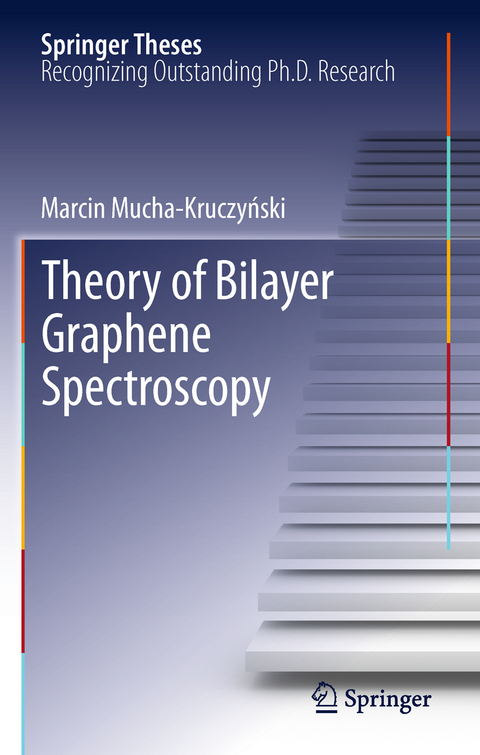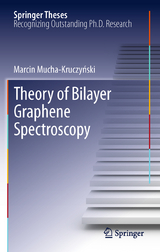Theory of Bilayer Graphene Spectroscopy
Seiten
2012
|
2013
Springer Berlin (Verlag)
978-3-642-30935-9 (ISBN)
Springer Berlin (Verlag)
978-3-642-30935-9 (ISBN)
This book presents the theory of three key elements of optical spectroscopy of the electronic excitations in bilayer graphene: angle-resolved photoemission spectroscopy (ARPES), visible range Raman spectroscopy, and far-infrared (FIR) magneto-spectroscopy.
This thesis presents the theory of three key elements of optical spectroscopy of the electronic excitations in bilayer graphene: angle-resolved photoemission spectroscopy (ARPES), visible range Raman spectroscopy, and far-infrared (FIR) magneto-spectroscopy. Bilayer graphene (BLG) is an atomic two-dimensional crystal consisting of two honeycomb monolayers of carbon, arranged according to Bernal stacking. The unperturbed BLG has a unique band structure, which features chiral states of electrons with a characteristic Berry phase of 2$pi$, and it has versatile properties which can be controlled by an externally applied transverse electric field and strain. It is shown in this work how ARPES of BLG can be used to obtain direct information about the chirality of electron states in the crystal. The author goes on to describe the influence of the interlayer asymmetry, which opens a gap in BLG, on ARPES and on FIR spectra in a strong magnetic field. Finally, he presents a comprehensive theory of inelastic Raman scattering resulting in the electron-hole excitations in bilayer graphene, at zero and quantizing magnetic fields. This predicts their polarization properties and peculiar selection rules in terms of the inter-Landau-level transitions.
This thesis presents the theory of three key elements of optical spectroscopy of the electronic excitations in bilayer graphene: angle-resolved photoemission spectroscopy (ARPES), visible range Raman spectroscopy, and far-infrared (FIR) magneto-spectroscopy. Bilayer graphene (BLG) is an atomic two-dimensional crystal consisting of two honeycomb monolayers of carbon, arranged according to Bernal stacking. The unperturbed BLG has a unique band structure, which features chiral states of electrons with a characteristic Berry phase of 2$pi$, and it has versatile properties which can be controlled by an externally applied transverse electric field and strain. It is shown in this work how ARPES of BLG can be used to obtain direct information about the chirality of electron states in the crystal. The author goes on to describe the influence of the interlayer asymmetry, which opens a gap in BLG, on ARPES and on FIR spectra in a strong magnetic field. Finally, he presents a comprehensive theory of inelastic Raman scattering resulting in the electron-hole excitations in bilayer graphene, at zero and quantizing magnetic fields. This predicts their polarization properties and peculiar selection rules in terms of the inter-Landau-level transitions.
The Tight-Binding Approach and the Resulting Electronic Structure.- Angle-Resolved Photoemission Spectroscopy.- Magneto-Optical Spectroscopy.- Electronic Raman Spectroscopy.
| Erscheint lt. Verlag | 6.9.2012 |
|---|---|
| Reihe/Serie | Springer Theses |
| Zusatzinfo | X, 86 p. |
| Verlagsort | Berlin |
| Sprache | englisch |
| Maße | 155 x 235 mm |
| Gewicht | 292 g |
| Themenwelt | Naturwissenschaften ► Chemie ► Analytische Chemie |
| Naturwissenschaften ► Chemie ► Physikalische Chemie | |
| Naturwissenschaften ► Physik / Astronomie ► Festkörperphysik | |
| Technik ► Maschinenbau | |
| Schlagworte | Bilayer Graphene • Chiral Electron States in Graphene • Electron-hole Excitations in Graphene • Electronic Structure of Bilayer Graphene • Graphene • Graphene Interlayer Asymmetry • Graphene Spectroscopy • Graphene Tight-binding • Spektroskopie • Studying BLG |
| ISBN-10 | 3-642-30935-6 / 3642309356 |
| ISBN-13 | 978-3-642-30935-9 / 9783642309359 |
| Zustand | Neuware |
| Haben Sie eine Frage zum Produkt? |
Mehr entdecken
aus dem Bereich
aus dem Bereich




